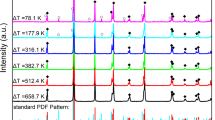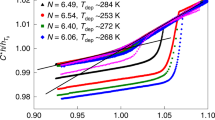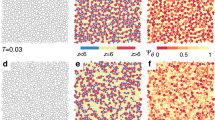Abstract
Semi-crystalline polymers containing amorphous and crystalline regions usually have intimately mixed chains. The resulting topological constraints (entanglements) in the amorphous regions limit the drawability in the solid state. By controlled synthesis the number of entanglements can be reduced. Ultimately, crystals composed of single chains are feasible, where the chains are fully separated from each other. If such separation can be maintained in the melt a new melt state can be formed. Here we show that through slow and carefully controlled melting such polymer crystals form a heterogeneous melt with more entangled regions, where the chains are mixed, and less entangled ones, composed of individually separated chains. Chain reptation, required for the homogenization of the entanglement distribution, is found to be considerably hindered. The long-lived heterogeneous melt shows decreased melt viscosity and provides enhanced drawability on crystallization. This novel route to create heterogeneous melt should be applicable to polymers in general.
This is a preview of subscription content, access via your institution
Access options
Subscribe to this journal
Receive 12 print issues and online access
$259.00 per year
only $21.58 per issue
Buy this article
- Purchase on Springer Link
- Instant access to full article PDF
Prices may be subject to local taxes which are calculated during checkout






Similar content being viewed by others
References
Doi, M. & Edwards, S. F. The Theory of Polymer Dynamics (Clarendon, Oxford, 1986).
De Gennes, P. G. Scaling Concepts in Polymer Physics (Cornell Univ. Press, Ithaca, 1979).
Rastogi, S., Goossens, J. G. P., Spoelstra, A. B. & Lemstra, P. J. Chain mobility in polymer systems: on the borderline between solid and melt. 1. Lamellar doubling during annealing of polyethylene. Macromolecules 30, 7880–7889 (1997).
Rastogi, S. et al. A novel route to fatigue resistant fully sintered UHMW-PE for knee-prosthesis. Biomacromolecules 6, 942–947 (2005).
Corbeij-Kurelec, L. Chain Mobility in Polymer Systems; On the Borderline between Solid and Melt Thesis, Ch. 7 Eindhoven Univ. of Technology (2001).
Rastogi, S. & Kurelec, L. Polymorphism in polymers; its implications for polymer crystallisation. J. Mater. Sci. 35, 5121–5138 (2000).
De Gennes, P. G. Explosion à la fusion. C. R. Acad. Sci. Paris II 321, 363–365 (1995).
Barham, P. & Sadler, D. M. A neutron scattering study of the melting behaviour of polyethylene single crystals. Polymer 32, 393–395 (1991).
Tracht, U. et al. Length scale of dynamic heterogeneities at the glass transition determined by multidimensional nuclear magnetic resonance. Phys. Rev. Lett. 81, 2727–2730 (1998).
Graf, R., Heuer, A. & Spiess, H. W. Chain-order effects in polymer melts probed by 1H double-quantum NMR spectroscopy. Phys. Rev. Lett. 80, 5738–5741 (1998).
Schmidt-Rohr, K. & Spiess, H. W. Multidimensional Solid-State NMR and Polymers (Academic, New York, 1994).
Likhtman, A. E. & McLeish, T. C. B. Quantitative theory for linear dynamics of linear entangled polymers. Macromolecules 35, 6332–6343 (2002).
Graham, R. S., Likhtman, A. E., McLeish, T. C. B. & Milner, S. T. Microscopic theory of linear, entangled polymer chains under rapid deformation including chain stretch and convective constraint release. J. Rheol. 47, 1171–1200 (2003).
Mc Leish, T. C. B. & Milner, S. T. Entangled dynamics and melt flow of branched polymers. Adv. Polym. Sci. 143, 195–231 (1999).
Wischnewski, A., Monkenbuch, M., Willner, L., Richter, D. & Kali, G. Direct observation of the transition from free to constrained single-segment motion in entangled polymer melts. Phys. Rev. Lett. 90, 583021–583024 (2003).
Bates, F. S., Wignall, G. D. & Koehler, W. C. Critical behaviour of binary liquid mixtures of deuterated and protonated polymers. Phys. Rev. Lett. 55, 2425–2428 (1985).
Ferry, J. D. Viscoelastic Properties of Polymers 3rd edn (Wiley, New York, 1980).
Raju, V. R., Manezes, E. V., Marin, G., Graessley, W. W. & Fetters, L. J. Concentration and molecular weight dependence of viscoelastic properties in linear and star polymers. Macromolecules 14, 1668–1676 (1981).
Carella, J. M., Graessley, W. W. & Fetters, L. J. Effects of chain microstructure on the viscoelastic properties of linear polymer melts: polybutadienes and hydrogenated polybutadienes. Macromolecules 17, 2775–2786 (1984).
Wood-Adams, P. M., Dealy, J. M., de Groot, A. W. & Redwine, O. D. Effect of molecular structure on the linear viscoelastic behaviour of polyethylene. Macromolecules 33, 7489–7499 (2000).
Lohse, D. J. et al. Well-defined, model long chain branched polyethylene. 2. Melt rheological behaviour. Macromolecules 35, 3066–3075 (2002).
Vega, J. F., Rastogi, S., Peters, G. W. M. & Meijer, H. E. H. Rheology and reptation of linear polymers: Ultra high molecular weight chain dynamics in the melt. J. Rheol. 48, 663–678 (2004).
Rotzinger, B. P., Chanzy, H. D. & Smith, P. High strength/high modulus polyethylene: synthesis and processing of ultra-high molecular weight virgin powders. Polymer 30, 1814–1819 (1989).
Smith, P. & Lemstra, P. J. Ultra-high-strength polyethylene filaments by solution spinning/drawing. J. Mater. Sci. 15, 505–514 (1980).
Lemstra, P. J., Bastiaansen, C. W. M. & Rastogi, S. in Structure Formation in Polymeric Fibers (ed. Salem, D. R.) Ch. 5 (Hanser, Munich, 2000).
Bastiaansen, C. W. M., Meijer, H. E. H. & Lemstra, P. J. Memory effects in polyethylenes: influence of processing and crystallization history. Polymer 31, 1435–1440 (1990).
Acknowledgements
The authors wish to thank H. E. H. Meijer, C. Bailly, J. F. Vega, R. Duchateau and P. Magusin for constructive discussions.
Author information
Authors and Affiliations
Corresponding author
Ethics declarations
Competing interests
The authors declare no competing financial interests.
Supplementary information
Supplementary Information
Supplementary annexures I - IV and supplementary figures (PDF 309 kb)
Rights and permissions
About this article
Cite this article
Rastogi, S., Lippits, D., Peters, G. et al. Heterogeneity in polymer melts from melting of polymer crystals. Nature Mater 4, 635–641 (2005). https://doi.org/10.1038/nmat1437
Received:
Accepted:
Published:
Issue Date:
DOI: https://doi.org/10.1038/nmat1437
This article is cited by
-
Olefin Polymerization Behavior of Titanium(IV) Complexes with Fluorinated and Non-fluorinated Aliphatic Phenoxyimine Ligands
Chinese Journal of Polymer Science (2024)
-
Polymer chain conformations in hybrid composites of UHMWPE incorporated by GNP/MWCNT
Journal of Polymer Research (2023)
-
The effect of diethylene glycol distearate on the flowability of abs and its lubrication mechanism
Journal of Polymer Research (2023)
-
Effect of calcium stearate and a fluoroelastomer on the flowability of UHMWPE/HDPE composites and the underlying mechanism
Journal of Polymer Research (2023)
-
Origin of high thermal conductivity in disentangled ultra-high molecular weight polyethylene films: ballistic phonons within enlarged crystals
Nature Communications (2022)



